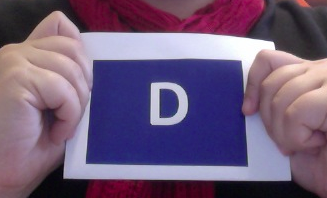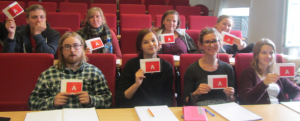
Introducing voting cards (post 3/3)
How do you introduce voting cards as a new method in a way that minimizes student resistance?
As all new methods, voting cards (see post on the method here, and on what kind of questions to ask here) first seem scary. After all, students don’t know what will happen if they happen to chose the wrong answer. Will they be called out on it by the instructor? Will everybody point at them and laugh? And even if they chose the correct answer, will the instructor make them explain why they chose that answer?

Some of my students in a staged photo. They are showing their favorite color to demonstrate the method for you. Thanks for posing for me!
When I introduce voting cards to a new group of students, I make sure to talk through all issues before actually using the cards. It is important to reassure the students that wrong answers will not be pointed out publicly, for example. It helps to use a very simple question that does not have right or wrong answers (“Which of these four colors is your favorite? Show me the one you like best!”) for the very first vote, so students get to experience the process without there being anything at stake. While showing their favorite color, they see that they cannot actually see their neighbors’ choices without making it very obvious (at least not in the classical lecture theatre setting that we are in, but even in other settings it is difficult). Hence their peers cannot actually see their own choice, either, without again making it very obvious.

In the picture above, students are very happy to show their votes to everybody – after all, there is no wrong answer and I asked them to pose. But this is what it typically looks like after students have gotten used to the method. During the first classes, voting usually looks more like this: Very close to the chest, held with both hands, shielding it from the neighbors.
During the first classes, voting usually looks like pictured above: Very close to the chest, held with both hands, shielding it from the neighbors.
Still there is probably going to be some resistance about committing to one answer because, after all, the instructor will still see it. But in my experience this can be overcome when the reasons for choosing the method are made sufficiently clear – that it benefits them to commit to one answer, because making thought processes explicit helps their learning. That it helps me, because I get a better feel of whether everybody understood a concept or only just the two vocal students, and whether I need to go into more detail with a concept or not. That it is a great basis for discussions.

Photo of an actual vote. In fact of the first vote after I asked them to pose for a staged photo (the one shown above). This question was clearly too easy!
After a couple of classes, voting cards are not even needed any more (although it can’t hurt to hand them out – it feels like less pressure if you could fall back on holding something up rather than speaking in public); discussion starts without having to be initiated through a voting process and subsequent questions for clarification. Also if they chose to still vote, students get much more daring in the way they hold up the cards – they stop caring about whether their peers can see what they voted for. So all in all a great technique to engage students.